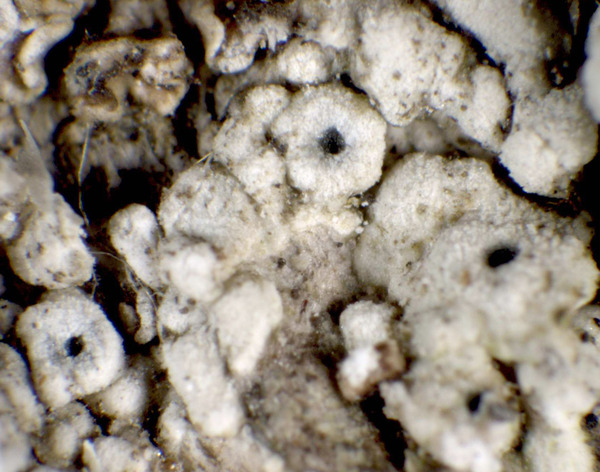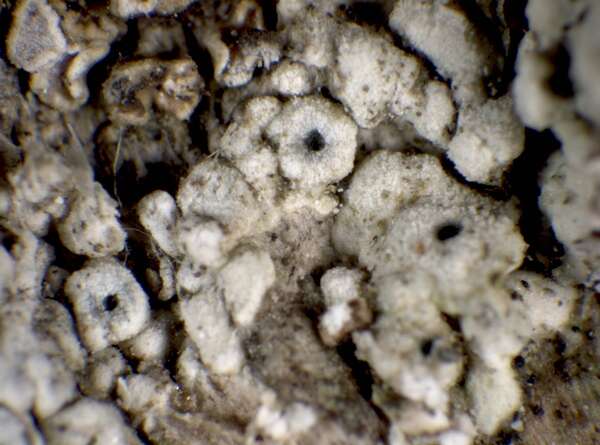Pertusaria sommerfeltii (Sommerf.) Fr.
Lichenogr. Eur. Ref.: 423, 1831. Basionym: Endocarpon sommerfeltii Flörke ex Sommerf. - Suppl. Fl. Lappon.: 135, 1826.
Synonyms: Pertusaria angusticollis Anzi; Pertusaria melastoma Nyl.
Description: Thallus crustose, endosubstratic or thinly episubstratic, continuous to faintly rimose, covered in fruiting warts, whitish, grey to greenish or yellowish grey, sometimes pruinose. Apothecia verruciform-perithecioid, completely immersed in basally not strongly constricted, apically flattened thalline warts which are c. 0.2-1.2 mm in diam., 1-3(-5) per wart, opening through dark brown punctiform pores. Epithecium dark brown to brown-black, K+ violet; hymenium colourless; paraphyses lax, branched and anastomosing; hypothecium yellowish. Asci (6-)8-spored, broadly cylindrical, the apex with a broad ocular chamber, the outer sheath K/I+ blue, otherwise K/I-, with an inner extensible layer, Pertusaria-type, with uniseriately arranged spores. Ascospores 1-celled, hyaline, oval to ellipsoid, (18-)22-35(-48) x (9-)10-33 µm, the wall 2-layered, the outer wall 1-3 µm thick, the inner wall 1-4 µm thick, smooth, the apices up to 8 µm thick. Photobiont chlorococcoid. Spot tests: K- or K+ faintly yellow, C-, KC- or KC+ faintly yellow, P- or P+ yellow-orange, UV- or UV+ weakly yellow. Chemistry: 4,5-dichloronorlichexanthone and stictic acid (both major), constictic acid and traces of unknowns (minor).
Growth form: Crustose
Substrata: bark
Photobiont: green algae other than Trentepohlia
Reproductive strategy: mainly sexual
Commonnes-rarity: (info)
Alpine belt: very rare
Subalpine belt: rather common
Montane belt: absent
Dry submediterranean belt: absent
Humid submediterranean belt: absent
Padanian area: absent
pH of the substrata:
1 2 3 4 5
Solar irradiation:
1 2 3 4 5
Aridity:
1 2 3 4 5
Eutrophication:
1 2 3 4 5
Poleotolerance:
0 1 2 3
Altitudinal distribution:
1 2 3 4 5 6
Rarity
absent
extremely rare
very rare
rare
rather rare
rather common
common
very common
extremely common
Loading data...
Occurrence data
Predictive map
Growth form: Crustose
Substrata: bark
Photobiont: green algae other than Trentepohlia
Reproductive strategy: mainly sexual
Commonnes-rarity: (info)
Alpine belt: very rare
Subalpine belt: rather common
Montane belt: absent
Dry submediterranean belt: absent
Humid submediterranean belt: absent
Padanian area: absent
pH of the substrata:
| 1 | 2 | 3 | 4 | 5 |
Solar irradiation:
| 1 | 2 | 3 | 4 | 5 |
Aridity:
| 1 | 2 | 3 | 4 | 5 |
Eutrophication:
| 1 | 2 | 3 | 4 | 5 |
Poleotolerance:
| 0 | 1 | 2 | 3 |
Altitudinal distribution:
| 1 | 2 | 3 | 4 | 5 | 6 |
Rarity
absent
extremely rare
very rare
rare
rather rare
rather common
common
very common
extremely common
Loading data...
Occurrence data
Predictive map









